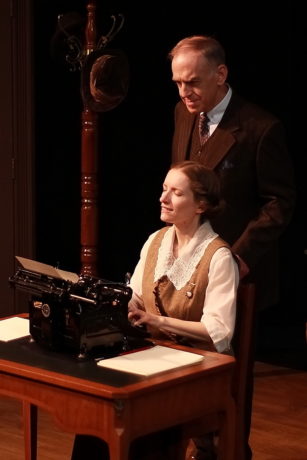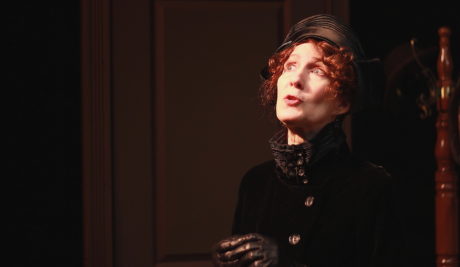Laura Giannarelli is a woman of many roles. A founder of Washington Stage Guild, she’s been a fixture of the DC stage for almost four decades.
She’s been the mother-in-law from hell in Gulf View Drive, the accuser in Doubt and the voice behind many of the “talking books” at the Library of Congress.

Now she’s directing Ghost-Writer, Michael Hollinger’s beautifully-wrought drama about a writer, his secretary, and his wife. The play, a poignant but funny riff on love and typing, is currently in a limited run at the Quotidian Theatre in Bethesda.
Set in 1919, the play is part mystery, part romance.
DCMTA’s review calls it “haunting,” and that’s not surprising, considering that the writer—a famous novelist named Franklin Woolsey, played with hilarious bluster and a hint of naughtiness by Steve LaRocque—happens to expire in the middle of dictating a novel.
The secretary, a prim but infatuated young woman named Myra Babbage, goes right on typing. She types in a kind of blind ecstasy, pounding out words that are actually better than those that were written before! No wonder everyone, including the writer’s widow, is suspicious.
Is it Franklin’s ghost who is dictating the words? Or is it the secretary herself? That’s the mystery. And Myra, who is portrayed by Carol Spring with such rapture and joy that at times she seems to levitate, is the crucial piece in the puzzle.

Sustaining the mystery is part of the fun, Giannarelli told me when we spoke over the phone during rehearsals. “It’s a matter of interpretation, but I want the audience to decide.”
She learned the importance of leaving the answers up in the air when she played the role of Sister Aloysius in Doubt, John Patrick Shanley’s play about a priest suspected of being a pedophile.
“This was about 10 years ago, at the Everyman Theatre in Baltimore. The director, Vinny Lancisi, didn’t tell me whether or not the priest was guilty. Instead, he told me to create my own back story, but to keep it secret,” she explained.
In Ghost-Writer, the same question arose. “Here, too, I didn’t want to know the answer. I left it to Myra—and the audience—to decide.”
As a director, the biggest challenge she faced was differentiating past and present in a series of flashbacks. “The two central characters are constantly on stage, yet they shift back and forth, alternating between memory and reality. It’s difficult to convey that, yet essential for the plot.”
At the performance I saw, all three of the characters seemed to move easily through time. In Myra’s case, in particular, the change was so dramatic that it was as though she were playing two roles at once. Subservience turned into courage. Radiance swerved into rapture.
No wonder the wife, Vivian Woolsey—played with great bitchiness and bravado by Stephanie Mumford—suspects that something is going on. She recognizes the attraction from the beginning, though the two participants, Franklin and Myra, take a bit longer to catch on.

Vivan tries to get rid of Myra, urging her, first, to hurry up and get married. When that doesn’t work, she threatens, cajoles, and even tries to learn typing herself, in an effort to unseat the adoring young woman who has clearly replaced her in Franklin’s affections.
Ghost-Writer is based loosely on the relationship between Henry James and his secretary, Theodora Bosanquet, who continued taking dictation, even after the writer had suffered a stroke.
But that’s where the similarity ends, according to Giannarelli. While James awoke “with a clouded mind,” Woolsey drops dead, right in the middle of dictating a sentence.
“I would call it ‘inspired’ by James,” she said. He and Woolsey share certain traits—both are rigid in their writing habits and both are dependent on a secretary who is part typist and part muse—but the fictional writer is not Henry James at all.
Ghost-Writer is Giannarelli’s third directing assignment at Quotidian, following on the heels of Faith Healer by Brian Friel in 2014 and A Lesson From Aloes by Athol Fugard two years later. The collaboration is no coincidence. She and Mumford, who founded the theater with Jack Sbarbori in 1997, worked together at Washington Stage Guild for many years.
“We would work together more often if we could, but our schedules often conflict,” the director said, pointing out that both theaters stress the importance of honoring the playwright’s intent.
A graduate of Catholic University, Giannarelli chose to stay in DC at a time when most of her drama school classmates were making a beeline for New York. Since then, she has performed on virtually every stage in the Washington area.
Offstage, she works for the Library of Congress, where—along with countless other theater professionals—she produces audio books for the blind and handicapped. Known as “Talking Books,” the service was authorized by Congress in 1931.
“I heard about it serendipitously, when I was working at the Olney Theatre in 1979,” she said. That was 40 years ago and she’s been there ever since. “Longer than anyone else,” she laughed, “but I love it.”
Running Time: 90 minutes, with no intermission.
Ghost-Writer plays through April 28, 2019, at the Quotidian Theatre, located inside The Writer’s Center at 4508 Walsh St, Bethesda, MD. For tickets, call 301-816-1023 or go online.
Note: Michael Hollinger’s talk-back, highlighted in DCMTA last week, is sold out. However, tickets are still available for other performances.
A Postscript:
As often happens at Quotidian, much of the drama in Ghost-Writer is in the details. The props, in particular, are always accurate for the period. Looking around the set, for example, one sees …
A vintage Victrola, complete with its logo of a dog listening to “his master’s voice,”…
A manual typewriter, made by Nauman Ideal and produced, most likely, in 1909…
Lace curtains at the windows overlooking the Queensboro Bridge…
The costumes include a ball gown as revealing as it is inappropriate for lunch …
And a mourning outfit as dark and angry as the jealous widow inside it. (Stephanie Mumford, the widow in question, is also the designer.)
Most astonishing of all, there is real tea in the teacups and tea leaves in the strainer.
-Ravelle Brickman




